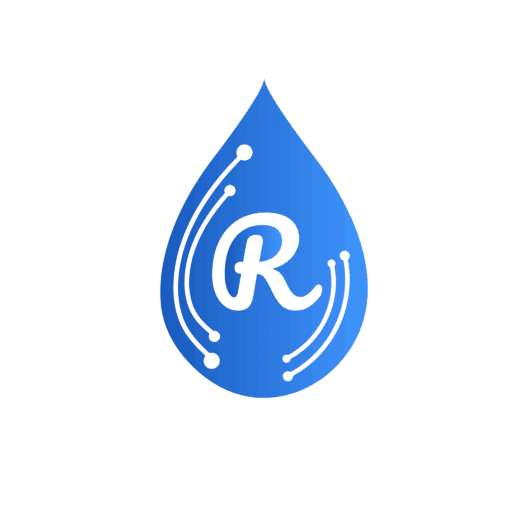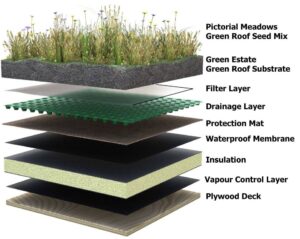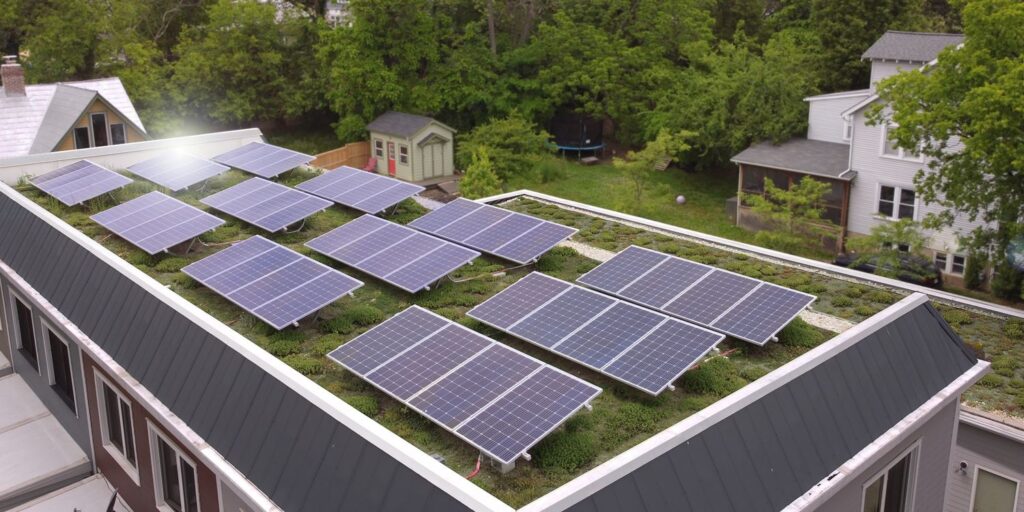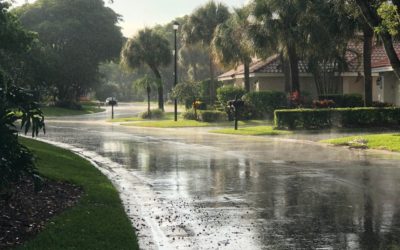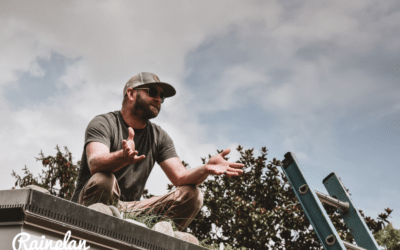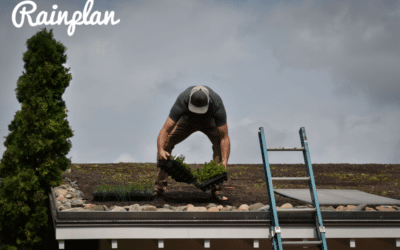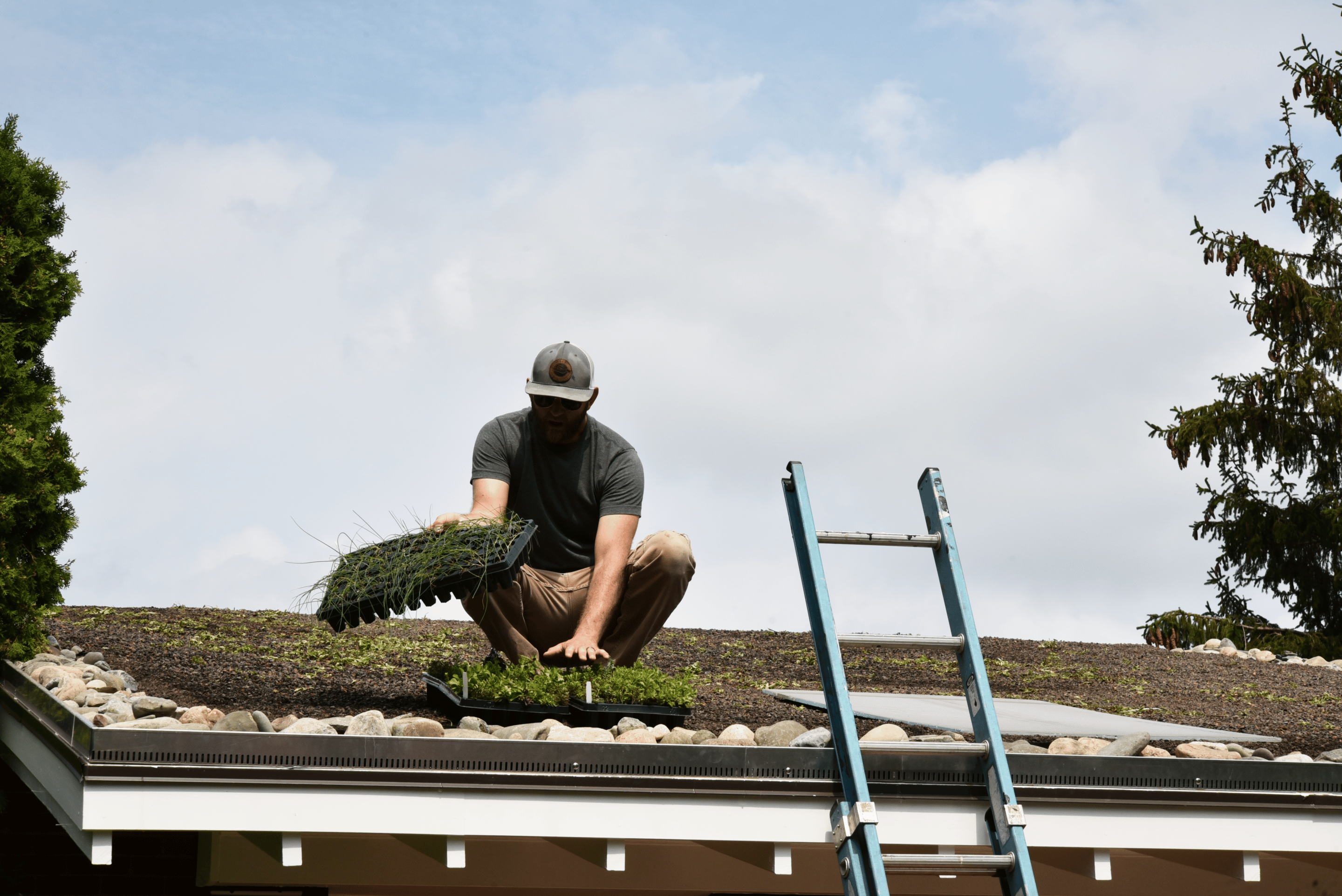
Green Roof
A green roof, or living roof, is the roof of a building that is partially or completely covered with vegetation and a growing medium, planted over a waterproofing membrane. It may also include additional layers such as a root barrier and drainage and irrigation systems.
Find green roof incentive programs by typing in your address!
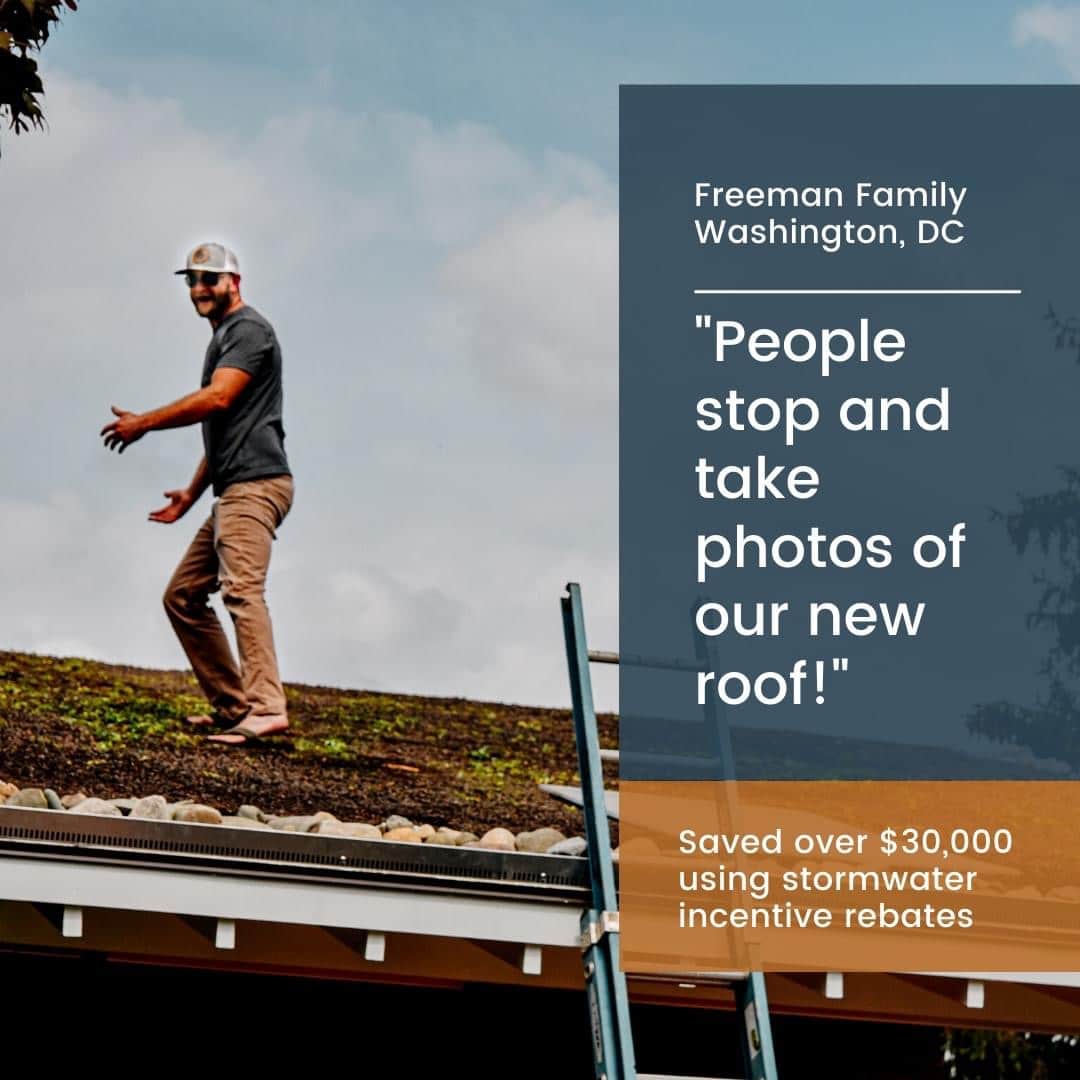
Low Maintenance
Filters Pollutants
Increases Property Value
Reduces Runoff
Recharge Groundwater
Improve Curb Appeal
Support Pollinators
Generous Incentives
DIY Friendly
General Questions About Green Roofs
How do green roofs work?
A regular roof sends stormwater right to storm drains and streams. Meanwhile, plants on a green roof slow down rain when it reaches t
he roof. When this happens the water absorbs into the soil or evaporates into the air.
The roots of the plants also keep the soil in place as it removes pollution from the water. Together, plants and soil reduce how much stormwater runoff reaches the ground, storm drains, and creeks.
The best locations for a green roof are sunny, horizontal spaces with a small slope. It’s also important that a building can support the weight of a green roof.
What are the benefits of a living roof?
- Save you money on energy bills.
- Extra insulation for your property
- Help you retain and redirect rainfall
- Prevent flooding
- Extend the life of your roof by as much as 10 years
- Increase usable green space
What type of plants can I grow on my living (green) roof?
Intensive commercial grade green roofs can support a wide variety of shrubs, and even some small trees. A less intensive project may include wildflowers and drought-tolerant herbaceous perennials. The most common sort of plants that can be observed in a green roof is all varieties of sedum, perennial plants with thick, succulent leaves, fleshy stems, and clusters of star-shaped flowers. There are over 600 varieties of sedum, so it’s always a good idea to speak to a local specialist about which type are best for your geographic area. Your local rain planner can help you get connected, so just reach out if you’re seriously considering a green roof project and we can help.
How do I know if I can use my existing roof?
We have an allowance available to complete a structural assessment. The assessment is performed to ensure the roof can sustain the weight of the Green Roof. In addition, if you desire, we can give you a price to replace the roof but most people place the Green Roof onto their existing roof. A Green Roof also extends the life of the home’s roof.
What elements are necessary for a successful green roof project?
There are a few key factors that go into executing your project on a new or existing roof. The most important considerations are:
- The Integrity of the Waterproofing Membrane: The roof’s membrane needs to be in good condition to make sure the roof will remain waterproof.
- Structure Load Constraints: The roof needs to be able to hold the added weight of the Green Roof. Before a green roof project starts, a structural assessment needs to be conducted to ensure the roof’s ability to hold that weight. In some cases, additional reinforcements need to be installed to support the added weight.
- The Slope of the Roof: The EcoCline green roof (just one of many brands) can be installed normally on a roof that has less than 3/12 pitch. Any steeper than that some structural components need to be introduced. Due to the implications of a mismatch of this particular criteria, if it’s not crystal clear, we highly recommend consulting with a licensed installer to double-check the specifications. Let us know, and we’ll be happy to match you with a green roof specialist.
- Logistics and Access to the Roof: Finally, our installers need to know what kind of roof access is present at the property to make sure they have the right equipment to get on the roof. Before starting the installation process we will have a structural engineer examine your property to ascertain whether or not any structural supports are needed.
How long does a Green Roof last?
Two things degrade the roof – expansion due to weather and exposure to the UV rays. A green roof dramatically extends the life of the roof by protecting it from those elements. The lifespan of a green roof is over 50 years.
How many days does it take to complete a green roof project?
Once the structural assessment is made and if the roof is fit for a green roof the actual installation can be done in a day or two. Our installers put the roof components in the facility prior to the job and only have to put the pieces together on site. Which reduces the time it takes to finish the project significantly.
Does the owner have to leave the property while the Green Roof is being installed?
If it’s just the Green Roof, which is an overlay of the existing roof, there’s no penetration in the roof, so therefore there’s no requirement for anyone to leave the home. These types of green roof installations typically take about 1 to 3 days.
How much does a green roof typically cost?
Green Roofs typically cost between $20 and $30 dollars per square foot if no roof replacements or structural reinforcements are needed. Structural reinforcements typically cost $3-4 per square foot and roof replacements (with PTO) typically cost $6-7 per square foot.
Can I put chairs on my Green Roof to be able to use it as a hangout area?
A Green Roof is like a lawn in that if you walk the same path every day and sit in the same chair you’ll wear a path in the lawn just like the green roof.
Do Green Roofs help with Heat Island Effect?
Cities are significantly hotter than surrounding areas. This is called the Urban Heat Island Effect. Buildings absorb and re-emit the sun’s heat increasing temperatures in urban areas. Plants absorb heat and provide shade. Green roof temperatures can be 30–40°F lower than those of conventional roofs and can reduce city-wide ambient temperatures by up to 5°F. Green roofs can also help reduce the distribution of dust and pollutants throughout the air which reduces air pollution and smog.
Are green roofs effective in retaining stormwater?
A study done by a University of Toronto civil engineer and co-researchers at the school’s Green Roof Innovation Testing Lab showed that green roofs have the capacity to capture an average of 70% of rainfall over a given time. For an average 1500 roof in DC that equates to saving 26,000 gallons a year from going into the sewer system.
Are green roofs fire retardant?
Living roofs have much lower burning heat load (the heat generated when a substance burns) than conventional roofs do which reduces fire risk to the building.
Are Green Roofs compatible with Solar?
Green roofs can be integrated with solar panels and actually increases their efficiency. By reducing the temperature of your roof, your living roof actually improves the performance of photovoltaic cells. Additionally, integrating green roofs with solar panels gives you the opportunity to stack available incentives and rebates.
Does having a green roof affect your property value?
Green roofs, like other forms of green infrastructure, are beautiful and increase property value. In New York City for example, apartments with green roofs had about 16% higher rental fees than buildings without living roof space. The same goes for residential property owners, green roofs can boost property value by 15%!
Is it true that green roofs reduce outside noise?
Installing a living roof can reduce sound from outside by up to 50 decibels. Replace annoying honking and construction noise with peace and quiet.
Are there energy savings associated with a Green Roof?
Living roofs provide insulation and help keep buildings cold in the summer and warm in the winter. This leads to significant energy savings. Research published by the National Research Council of Canada found that an extensive green roof reduced the daily energy demand for air conditioning in the summer by over 75%.
What if my green roof gets damaged?
There’s a warranty for the establishment if something that major happens. In most cases, damage will be covered under your homeowner’s insurance as a fixture.
From the Runoff
Intro to Green Infrastructure | Stormwater Systems
Wet Weather Turns into Water Runoff Stormwater runoff is the single largest cause of water pollution, flooding and property damage. According to FEMA, just one inch of rain can cause $25,000 of damage to your home. More than 22.4 million US properties are at risk of...
Expert Tips: Green Roof Maintenance
Your Green Roof in Winter You installed your green roof and with winter approaching you wonder what happens next. It might be tempting to walk away from it during the cold months and re-adjust come spring, but even green roofs need TLC during winter. Mike White of...
Why Green Roofs Are the Best Project for 2022
An aerial view of a standard city or neighborhood usually shows a sea of rooftops made of asphalt, concrete, and tar. What a beautiful world we would live in if those bleak rooftops were covered with lush, green vegetation. Let us introduce you to a roof idea, a...
Find green roof incentive programs by typing in your address!
Uplifting economies & environments is our mission.
Is Rainplan a contractor?
No, we match you with the best contractors in your area and help you navigate the installation process.
What are the steps of the rainplan process?
Once you submit your address we will send you a Rainplan assessment that will include an analysis on your property, what type of technologies we recommend, the amount of government funding you’re eligible for, and a pricing estimate.
Afterwards we send a contractor or engineer to your property depending on the type of upgrade you’re looking to do. A structural engineer will evaluate the structural integrity of your property for a Green Roof, and a landscape designer will conduct a percolation test on your soil and the design for the installation on your soil for permeable pavers and rain gardens.
We’ll then send you finalized pricing and if you accept we will submit your property for incentive approval and afterwards begin the installation process.
How does Rainplan work with the government?
Yes, Rain Plan is a for-profit, private organization. We have no contractual or affiliation with the government. We provide storm water services where we assess the property, connect to installers and fund the work so there’s no out-of-pocket cost for the property owners.
We administer the application process into the local jurisdictions for the programs. For example; In DC they have numerous programs, one of them is the River Smart Rewards Program and the Chesapeake Bay Trust.
We have no affiliation but we provide a service to make it easier for property owners to make upgrades but also obtain incentives from the government. This is not only meant to be a concierge service but also a way to guarantee your incentive and not come out of pocket for the entire amount while waiting on your incentive rebate after the project is complete.
What type of technologies does Rainplan offer?
Green Roofs, Permeable Pavers, Rain Gardens, Rain Barrels
What is the homeowner responsible for?
In addition to the installation fee, the property owner is responsible for:
A- Providing Rainplan with access to the property throughout the installation process.
B- Assigning payment to Rainplan of any stormwater installation rebates.
C- Annual maintenance of stormwater improvements to ensure property owner remains eligible for annual utility fee discounts.
D- Any property damage. Stormwater upgrades are designed to capture the first 1.2 inches of rainfall and Rainplan does not guarantee protection from severe weather, and or other property related events.
